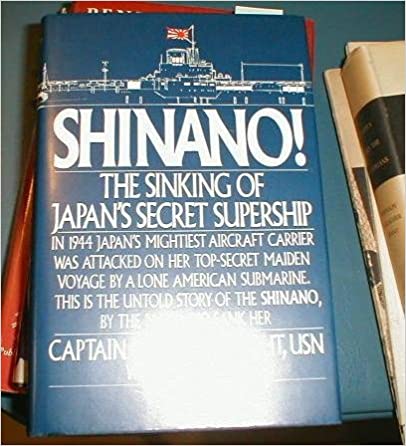Shinano! The Sinking Of Japan's Secret Supership

In this story is some World War II history that is not commonly told. The fact that the Captain of the submarine, Joseph F. Enright, is telling the story makes it all the much better. The fact that Captain Enright has been given full permission to tell his tale complete with references to certain “Secret information” adds an interesting element to the narrative that probably took place aboard many other ships than his own. While it is commonly thought that war is a decision against the enemy with the ally, there are other considerations that have to be weighed. Like a poker game, certain actions or movements allow your opponent to know what it is you think you know. If you know too well, the most likely assumption is that you have access to some of their secrets which means that either you have broken their codes, or you have spies in their ranks. Either one of those scenarios means that immediate action is necessary on the part of the compromised to ferret out any potential moles or bad actors.
This book gives you plenty of considerations along those lines in regard to if you were the Captain of the Archer-Fish, how would you have parsed the scenario given the variables that Captain Enright delineates?
What Captain Enright does in this book is to give his vanquished foes a voice. In a sense, his fame is directly attributable and entangled with all the men who went down on the Shinano which was the largest aircraft carrier built in World War II. The entire project was secretive, and originally the ship had aspirations to be a battleship but was instead converted to an aircraft carrier to attempt to turn the tides of the war back in Japan’s favor.
The problem, of course, is that the Japanese decision makers are in a hurry and act in haste and in pride. Though their engineering is novel the ship sets sail without being properly tested and outfitted. This puts the entire crew at a disadvantage and the decisions aboard the Shinano continually reflect a kind of arrogant thinking on the part of the Japanese. For one thing, they conclude that the Americans are “stupid” because they keep “pinging them” with radar noise, and the only logical explanation as far as Captain Toshio Abe is concerned is that the Americans must be hunting their new warship with a wolfpack of submarines. This is how the Japanese fought in the skies, and certainly there is evidence of the tactic at sea and so the Japanese project what must be true of their fighting style into the battlefield as opposed to considering that with decisive, aggressive action and superior firepower that they can simply defeat a lone sub that is stalking them.
Really, Captain Abe throughout the story, is portrayed as simply wanting to get the ship where it was going as quickly as possible. He, of course, pays the price for this dedicated focus by becoming a sacrifice along with the many other men on the ship that would go down with her after being impacted by four torpedoes that left gaping holes in the vessel.
The entire read is riveting, and horrifying. One can sympathize with both Captains to the point that one can forget that Japan is allied with Nazis from time to time which is, without a doubt, an evil that had to be quashed. Still, between the respective Captains, one begins to understand how each Captain is shouldering a lot of burden under the banner of “duty” and really neither of them especially want to be where they are. Captain Enright, it seems, has more of a delayed reaction but in his telling of this book, there is a definitive “needing to understand the enemy and the conditions and stories of the men” whom he played a key role in killing in naval combat.
The battle could have just as easily gone the other direction, had different decisions and orders and risk-taking been different within the personalities of the Captains. The aspect of how Japan handled the aftermath of all of this action at sea is just as interesting if not as reflective of a most evident hubris. The administration decides that those most worthy of blame, it seems, were the crew. The crew of the Shinano might have been the ultimate losers in the sense that even those who survived lived long enough to hate those who had issued the orders to dispatch them aboard their ill-fated vessel in the first place. Even the Destroyer escorts were of no immediate help, hog-tied by the orders of Abe who in turn was bound by Japanese military command. One cannot help but feel like just as the men in Pearl Harbor were sent to their deaths by a series of either errors or coordinated indifference, certainly the crew of the Shinano was another such sacrifice that need not have been.
The book left me disturbed by my own reactions to the story that was told but disturbed in a somewhat good way. The conclusion is that war is hell, which is a cliche, but that the absolute waste of human life and resources must border on something close to being unforgiveable. If you are a student of history, this book is well worth the read. Pick it up, and do not give it a second thought. You will have plenty of time for second thoughts when you finish the contents of the book. 